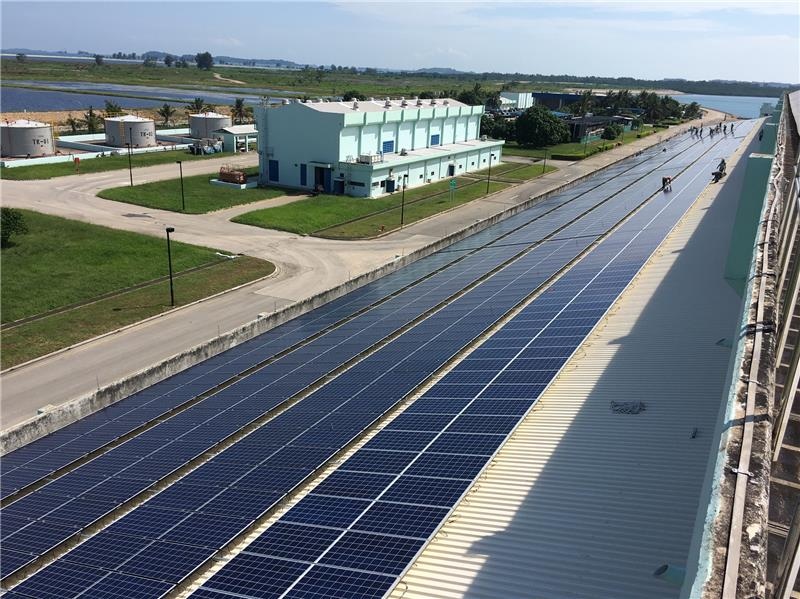Oct 27 2016
Nanyang Technological University (NTU Singapore) is building an offshore system that will integrate multiple renewable energy sources such as solar, wind, tidal, diesel, and power-to-gas technologies.
 NTU Singapore will be building the region’s first large-scale offshore microgrid system which is already equipped with 3,000 sq metres of photovoltaic panels that are already in operation.(Credit:Nanyang Technological University)
NTU Singapore will be building the region’s first large-scale offshore microgrid system which is already equipped with 3,000 sq metres of photovoltaic panels that are already in operation.(Credit:Nanyang Technological University)
The region’s first large-scale offshore power grid system, it will have four hybrid microgrids, occupying over 64,000 sq metres of land or roughly about eight soccer fields. The system will be built at Semakau Landfill which is managed by the National Environment Agency (NEA). It will have over 3,000 sq. metres of photovoltaic (PV) panels, including energy storage systems that are already in operation.
The deployment of the first hybrid microgrid was announced today by Mr Masagos Zulkifli, Minister for the Environment and Water Resources at the Asia Clean Energy Summit (ACES) held at the Sands Expo and Convention Centre, Marina Bay Sands.
“I am happy to announce that the first microgrid has just been deployed and it will enable the National Environment Agency (NEA) to power its infrastructure on Semakau Landfill using electricity generated through zero-carbon means. The use of energy storage and microgrid control technologies will allow the landfill to reduce its reliance on diesel-based power and transition towards renewable energy. I am also pleased to share that REIDS will deploy 3 further microgrids on Semakau Landfill to test the interoperability of various microgrid solutions.”
Once all four hybrid microgrids are fully built, they are expected to produce stable and consistent power in the megawatt (MW) range, suitable for small islands, isolated villages, and emergency power supplies.
It will also produce energy amounting to the equivalent of the average energy consumption of 250 4-room HDB flats for a year. Fish hatcheries and nurseries located at Semakau Landfill will be among the first to be powered.
Harnessing nature’s power
Built under the Renewable Energy Integration Demonstrator-Singapore (REIDS) initiative led by NTU, the hybrid power grid system will test the integration of solar, wind, tidal-current, diesel, energy storage and power-to-gas technologies and ensure these energy sources operate well together.
NTU Chief of Staff and Vice-President (Research) Prof Lam Khin Yong said “The deployment of this first hybrid microgrid is a big leap towards low-carbon electricity production for the nation and the region. As a global leader in sustainability research, NTU is proud to champion this ground-breaking initiative and lead Singapore’s charge in developing practical renewable energy solutions.”
Supported by the Singapore Economic Development Board (EDB) and NEA, NTU’s REIDS initiative will also facilitate the development and commercialisation of microgrid technologies suited for a tropical island.
Mr Goh Chee Kiong, Executive Director of Cleantech at EDB said, “Singapore has identified microgrids as a key growth area for the clean energy industry. REIDS is the largest microgrid R&D platform in Southeast Asia and therefore is instrumental to Singapore’s ambition to achieve a global leadership position in microgrids and serve the regional markets. Since its launch in 2014, the REIDS platform has been successful in attracting leading solution providers and regional adopters to develop, demonstrate and export microgrid solutions from Singapore.”
Mr Ronnie Tay, Chief Executive Officer of NEA, said, “The REIDS project will lead to innovative sustainable energy solutions that will help to address climate change. The National Environment Agency (NEA) is very pleased to support this landmark effort to explore the integration of renewable energy into micro-grid solutions.”
Managed by NTU’s Energy Research Institute (ERI@N), the REIDS initiative is expected to attract $20 million worth of projects over the next five years, in addition to the initial $10 million investment in infrastructure at the landfill.
Spearheading offshore microgrid solutions with strong industry support
REIDS has attracted investments from top energy and microgrid companies which aim to co-develop such solutions to serve the growing market in Southeast Asia.
The four microgrid systems will be developed by ENGIE, GE Grid Solutions, LS Industrial Solutions (LSIS) and Schneider Electric. Other partners include Accenture, Class NK, DLRE, Renewable Energy Corporation (REC), Trina Solar. LSIS and Sony were also announced as partners today at ACES 2016.
The REIDS platform will pave the way for similar technologies to be developed and exported to serve the numerous remote communities in Southeast Asia and beyond. It has already attracted the interest of regional adopters such as island communities and utilities.
For instance, Bawah Island, an Indonesian island in the South China Sea, and Meralco, the largest electric distribution company in the Philippines, will partner REIDS to develop offshore microgrid projects.
Source: http://www.ntu.edu.sg/